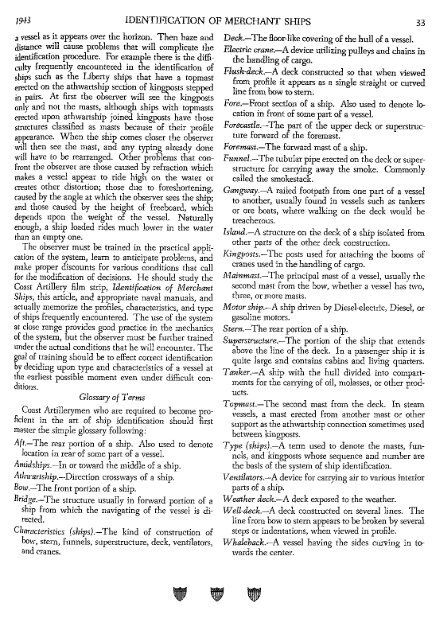January-February - Air Defense Artillery
January-February - Air Defense Artillery
January-February - Air Defense Artillery
Create successful ePaper yourself
Turn your PDF publications into a flip-book with our unique Google optimized e-Paper software.
1943 IDENTIFICATION OF MERCHANT SHIPS 33<br />
a vessel as it appears over the horizon. Then haze and<br />
distance will cause problems that V\.ill complicate the<br />
identification procedure. For example there is the difficulty<br />
frequently encountered in the identification of<br />
ships such as the Liberty ships that have a topmast<br />
erected on the athwartship section of kingposts stepped<br />
in pairs. At first the observer will see the kingposts<br />
only and not the masts, although ships with topmasts<br />
erected upon athwartship joined kingposts have those<br />
structures classified as masts because of their profile<br />
appearance. When the ship comes closer the observer<br />
will then see the mast, and any typing already done<br />
will have to be rearranged. Other problems that confront<br />
the observer are those caused by refraction which<br />
makes a vessel appear to ride high on the water or<br />
creates other distortion; those due to foreshortening,<br />
caused by the angle at which the observer sees the ship;<br />
and those caused by the height of freeboard, which<br />
depends upon the weight of the vessel. Naturally<br />
enough, a ship loaded rides much lower in the water<br />
than an empty one.<br />
The observer must be trained in the practical application<br />
of the system, learn to anticipate problems, and<br />
make proper discounts for various conditions that call<br />
for the modification of decisions. He should study the<br />
Coast <strong>Artillery</strong> film strip, Identification of Merchant<br />
Ships, this article, and appropriate naval manuals, and<br />
actually memorize the profiles, characteristics, and type<br />
of ships frequently encountered. The use of the system<br />
at close range provides good practice in the mechanics.<br />
of the system, but the observer must be further trained<br />
under the actual conditions that he will encounter. The<br />
goal of training should be to effect correct identification<br />
by deciding upon type and characteristics of a vessel at<br />
the earliest possible moment even under difficult conditions.<br />
Glossary of Terms<br />
Coast <strong>Artillery</strong>men who are required to become proficient<br />
in the art of ship identification should first<br />
master the simple glossary following:<br />
Aft.- The rear portion of a ship. Also used to denote<br />
location in rear of some part of a vessel.<br />
Amidships.-In or toward the middle of a ship.<br />
Atlnrartship.-Direction crossways of a ship.<br />
Bow.- The front portion of a ship.<br />
Bridge.- The structure usually in forward portion of a<br />
ship from which the navigating of the vessel is directed.<br />
Characteristics (ships).- The kind of construction of<br />
bow, stern, funnels, superstructure, deck, ventilators,<br />
and cranes.<br />
Deck.- The Hoor-like covering of the hull of a vessel.<br />
Electric crane.-A device utilizing pulleys and chains in<br />
the handling of cargo.<br />
Flush-deck.-A deck constructed so that when viewed<br />
from profile it appears as a single straight or curved<br />
line from bow to stem.<br />
Fore.-Front section of a ship. Also used to denote location<br />
in front of some part of a vessel.<br />
Forecastle.- The part of the upper deck or superstructure<br />
forward of the foremast.<br />
Foremast.- The forward mast of a ship.<br />
Funnel.- The tubular pipe erected on the deck or superstructure<br />
for carrying away the smoke. Commonly<br />
called the smokestack.<br />
Gangway.-A railed footpath from one part of a vessel<br />
to another, usually found in vessels such as tankers<br />
or ore boats, where walking on the deck would be<br />
treacherous.<br />
Island.-A structure on the deck of a ship isolated from<br />
other parts of the other deck construction.<br />
Kingposts.- The posts used for attaching the booms of<br />
cranes used in the handling of cargo.<br />
.Mainmast.- The principal mast of a vessel, usually the<br />
second mast from the bow, whether a vessel has two,<br />
three, or more masts.<br />
Motor ship.-A ship driven by Diesel-electric, Diesel, or<br />
gasoline motors.<br />
Stern.- The rear portion of a ship.<br />
Superstructure.- The portion of the ship that extends<br />
above the line of the deck. In a passenger ship it is<br />
quite large and contains cabins and living quarters.<br />
T anker.-A ship with the hull divided into compartments<br />
for the carrying of oil, molasses, or other products.<br />
T opmast.- The second mast from the deck. In steam<br />
vessels a mast erected from another mast or other<br />
suppor~ as the athwartship connection sometimes used<br />
between kingposts.<br />
Type (ships).-A term used to denote the masts, funnels,<br />
and kingposts whose sequence and number are<br />
the basis of the system of ship identification.<br />
Ventilators.-A device for carrying air to various interior<br />
parts of a ship.<br />
W wher deck.-A deck exposed to the weather.<br />
Well-deck.-A deck constructed on several lines. The<br />
line from bow to stem appears to be broken by several<br />
steps or indentations, when viewed in profile.<br />
Whaleback.-A vessel having the sides curving in to-<br />
1-vardsthe center.
















